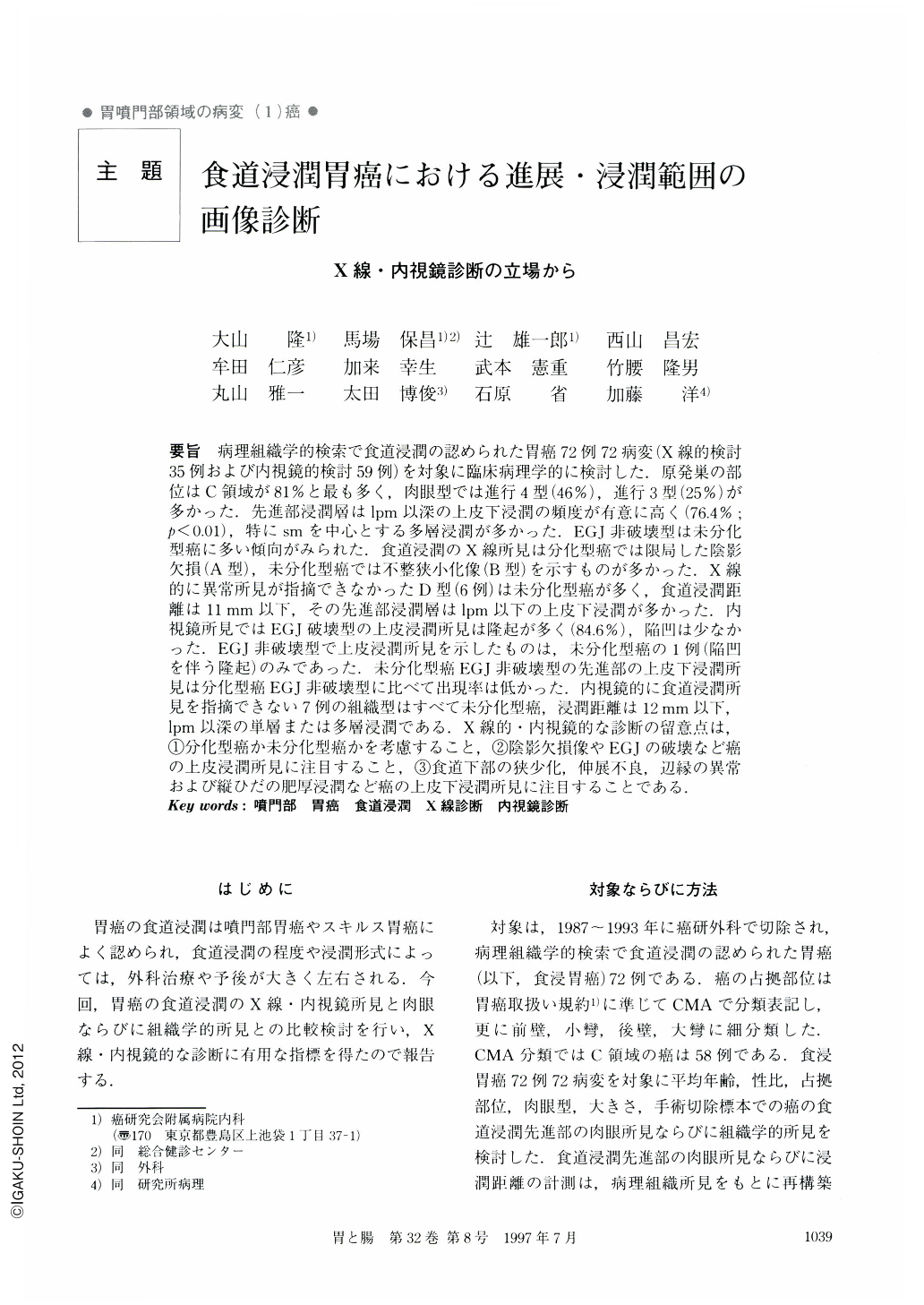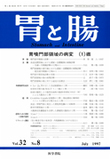Japanese
English
- 有料閲覧
- Abstract 文献概要
- 1ページ目 Look Inside
要旨 病理組織学的検索で食道浸潤の認められた胃癌72例72病変(X線的検討35例および内視鏡的検討59例)を対象に臨床病理学的に検討した.原発巣の部位はC領域が81%と最も多く,肉眼型では進行4型(46%),進行3型(25%)が多かった.先進部浸潤層はlpm以深の上皮下浸潤の頻度が有意に高く(76.4%;p<0.01),特にsmを中心とする多層浸潤が多かった.EGJ非破壊型は未分化型癌に多い傾向がみられた.食道浸潤のX線所見は分化型癌では限局した陰影欠損(A型),未分化型癌では不整狭小化像(B型)を示すものが多かった.X線的に異常所見が指摘できなかったD型(6例)は未分化型癌が多く,食道浸潤距離は11mm以下,その先進部浸潤層はlpm以下の上皮下浸潤が多かった.内視鏡所見ではEGJ破壊型の上皮浸潤所見は隆起が多く(84.6%),陥凹は少なかった.EGJ非破壊型で上皮浸潤所見を示したものは,未分化型癌の1例(陥凹を伴う隆起)のみであった.未分化型癌EGJ非破壊型の先進部の上皮下浸潤所見は分化型癌EGJ非破壊型に比べて出現率は低かった.内視鏡的に食道浸潤所見を指摘できない7例の組織型はすべて未分化型癌,浸潤距離は12mm以下,lpm以深の単層または多層浸潤である.X線的・内視鏡的な診断の留意点は,①分化型癌か未分化型癌かを考慮すること,②陰影欠損像やEGJの破壊など癌の上皮浸潤所見に注目すること,③食道下部の狭少化,伸展不良,辺縁の異常および縦ひだの肥厚浸潤など癌の上皮下浸潤所見に注目することである.
Seventy-two cases (72 lesions) of the gastric carcinoma with histologically proven esophageal invasion were analyzed clinicopathologically (35 cases of radiological evaluation and 59 cases of endoscopic evaluation). Majority of the primary lesions was located in the C area (81%), and macroscopically the advanced type 4 (46%) and advanced type 3 (25%) were commonly seen. Concerning the depth of invasion at the oral edge of invasion, subepithelial invasion with deeper than lpm was significantly common (76.4%, p<0.01), especially invasion to the multiple layers which were located mainly in the sm layer was popular. The esophagogastric junction (EGJ) destructive type was more likely to be seen in the undifferentiated type. There were some tendency in the radiologic findings of esophageal invasion; a filling detect of the well-demarcated area (type A) was popular in the differentiated carcinoma, whereas irregular narrowing (type B) was common in the undifferentiated carcinoma. The type D which was not detected by radiological examination (six cases) had following features; most of them were undifferentiated carcinoma, length of esophageal invasion was less than 11 mm, and the depth of invasion at the oral edge was limited to the subepithelium within the lpm layer. In the endoscopic findings, the majority of epithelial invasion of the EGJ destructive type was seen as protrusion (84.6%), and a few of them were seen as depressed lesions. The only one case with epithelial invasion found in the EGJ non-destructive type was undifferentiated type carcinoma (protrusion with depression). Findings suggesting subepithelial invasion at the oral edge of invasion in the EGJ undestructive type undifferentiated carcinoma were less commonly seen than in the EGJ undestructive type differentiated carcinoma. There were seven cases whose esophageal invasion was not detected endoscopically; all of them were undifferentiated carcinoma, length of invasion was less than 12 mm, and invasion was located in single or multiple layers of lpm or deeper. Radiologic and endoscopic diagnosis should be made carefully with following points: 1) consider whether it is the differentiated or undifferentiated carcinoma, 2) seek for findings suggesting epithelial invasion such as filling defects and destruction of the EGJ, 3) look for findings suggesting subepithelial invasion such as narrowing, poor wall expansion, marginal abnormality, and hypertrophy of the longitudinal folds in the lower esophagus.

Copyright © 1997, Igaku-Shoin Ltd. All rights reserved.


